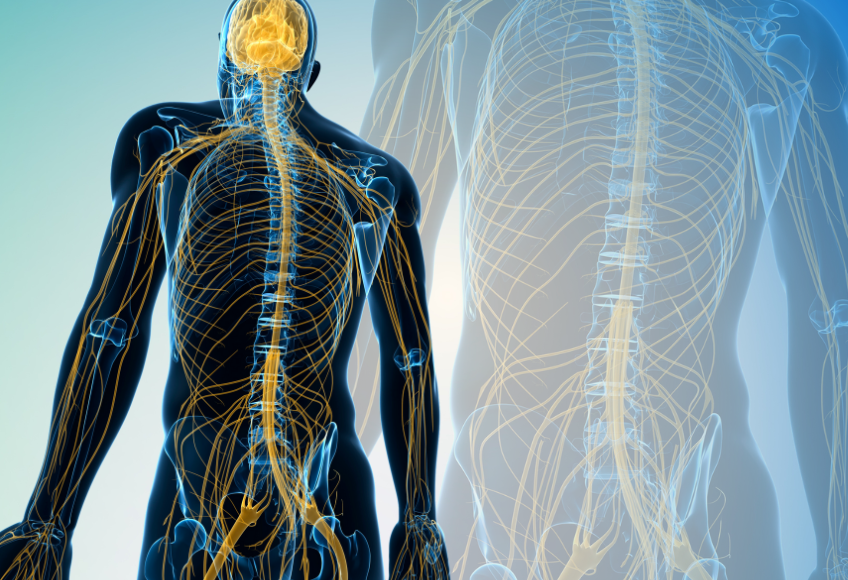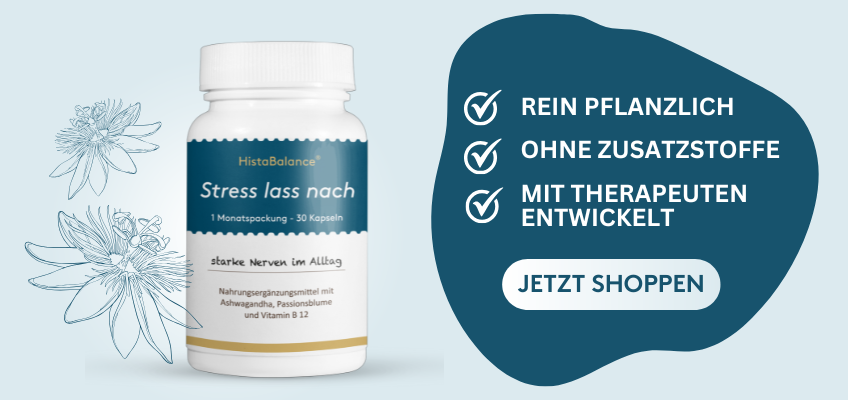
The vagus nerve
The vagus nerve is the longest nerve in the human body and runs from the brain to the abdomen. His name "Vagus" comes from Latin and means "around", which fits well with its numerous branches and connections to various organs and systems: it is associated with almost all internal organs. It is also a central part of the parasympathetic nervous system, which is responsible for the functions of calm and digestion. A strong vagus nerve supports recovery after stress and promotes our circulation and our immune system.
Sympathetic, parasympathetic and enteric nervous system
The Parasympathetic Is part of the vegetative nervous system And unconsciously controls most internal organs and the blood circulation. You also call him "Restorer" or "Recreational nerve“Because it ensures that the body recovers and saves energy. vegetative centers The parasympathetic is in the brain stem and in the sacred part of the Spinal cords (Kreuzmark). The nerves from the brain stem control the inner eye muscles, the tears and saliva glands as well as most internal organs over the vagus nerve. The nerves from the Kreuzmark influence the lower part of the colon, the bladder and genitals. Because of the location of the nerve cells, the parasympatheticism is also craniosacral system designated.
The Sympathetic On the other hand, control takes control when the body is under stress and has to do more. These two systems work together and balanced to control our organs. The sympathetic nerve cells are in the chest and lumbar area of the spinal cord. Higher centers of the sympathetic Hypothalamus And the brain stem send signals to these sympathetic nerve cells in the spinal cord. These nerve cells are in the Side horn of the spinal cord. They send their fibers to nerve cell groups next to the spine that are connected and together sympathetic border strand (Truncus Sympathicus) form. This also extends to the neck area (there as a Throat Described) and the sacrum.
The third part of the vegetative nervous system is that enteric nervous system, which Intestinal tract controlled. It is an independent nervous system and is a thin layer between the muscles of the digestive tract. It is his main task that digestion to be controlled. It can work completely autonomously, but is under the influence of the sympathetic and parasympathetic to with the entire organism in Clash to stay.
Share information about your brand with your Customers. Describe A Product, Make Announcements, Or Welcome Customers to your Store.
The role of the vagus nerve
The gastrointestinal tract and the brain are in constant exchange, one also speaks of the Darm-brain axis. The one plays a central role in this Vagus nerve. Among other things, this will Feeling of satiety and the Blood sugar level regulated during food intake. Researchers from the Cologne Max Planck Institute for Metabolic Research, the Cluster of Excellence for Aging Research Cecad at the University of Cologne and the Cologne University Hospital have the distribution of tasks of the Nerve cells in the vagus nerve More precisely examined and determined that although the nerve cells from the same Control center come, they control different regions in the body and opposite functions in the Regulation of the feeling of satiety and take over the blood sugar level. Some of these nerve cells react mechanical stimuli the organs, such as the expansion of the stomach, while other chemical signals, i.e. substances from our food, perceive. So our organs not only recognize how much we eat and when we are full, but also what we eat. This is one of the reasons why it is advisable that you are not distracted by external influences when eating. For example While eating on your cell phone are or read a newspaper, your body cannot really focus on digestion. Under certain circumstances will even be less digestive juices Produced and your digestive system is not sufficiently prepared for food intake. The situation is similar if you eat under stress. Furthermore, through a chronically activated sympathetic also Hypertension be triggered. In the long run, the risk for Strokes, heart failure and kidney failure be increased. Hyperture often remains unnoticed for a long time or is ignored. Symptoms like Dizziness, headache, sweating and racing heart are often not taken seriously or attributed to everyday stress. The most common treatment method is medication. But there are also alternative approaches: Endurance sports, yoga and walks can also be effective. These activities help to calm the nervous system and vagus nerve stressed by the stressful everyday life and to reduce blood pressure in a naturally way. Nevertheless, this should be checked by your family doctor in order to exclude other potential diseases.
As you can see, play yours for your vagus nerve Stress level A very big role. It makes sense for your general health if you regularly for one Compensation between sympathetic and parasympathetic worry. Because if only the system of the sympathicus is constantly under power, the body comes into an overwhelming. Many people are mainly in stress mode these days - relaxation is neglected. There is no time to reduce stress hormones, which can damage the body in the long run. According to the Disease protection authority in Atlanta arise 90% of all diseases due to stress. A research work by Dr. Lipton (Stanford University) increases this number to 95%. The remaining 5% are genetically predisposed. There are now a number of studies that prove that Illness an appearance of permanent stress is.
So no wonder that Stress of the Histamintrigger number 1 is. When stressed, the body pours the hormone Cortisol from that activates the nervous system (mainly the sympathetic) and the body in the "Combat or flight" mode offset. In this state, the body switches to energy -saving mode, which means that all functions that are not vital directly such as Digestion and cell repair can be set, for example also our digestion and detoxification. Become at the same time Neurotransmitter Like adrenaline and noradrenaline released to keep the body on alert and to activate the immune system. The immune system reacts to the alarm state by Mast cells triggered that release histamine. Histamine supports the immune system, increases the pulse and widens the blood vesselswhat continues to keep the body in the alarm state. With a Histamine intolerance Inevitably leads to a vicious circle of even more stress and more Histamine release.
Share information about your brand with your Customers. Describe A Product, Make Announcements, Or Welcome Customers to your Store.
Physiological and situational stress
The "Combat or flight" mode Can be life -saving in dangerous situations, but leads to serious problems with permanent activation. This persistent stress is called physiological stress. Chronic physiological stress causes a Continuous histamine releasethe immune system and others Organ systems overloaded and weakens what the Self -healing of the body prevents. If that "Stress barrel" Overflowing, weak areas in the body such as intestine, heart, skin or psyche can become sick, what to do Food intolerance, histamine intolerance, allergies and other diseases can lead.
Various research show that the "fighting or flight" mode through unconscious memories is triggered. These memories are stored in all body cells, not just in the brain. About 90% of our memories are unconscious and can activate the nervous system in certain situations and switch on the "combat or flight" mode without being able to control it. In this state the Reactive mind The leadership and bypasses logical thinking.
Situational stress, such as professional pressure, family problems, persistent environmental influences or financial concerns, can be used for long -term stress physiological stress lead.
Share information about your brand with your Customers. Describe A Product, Make Announcements, Or Welcome Customers to your Store.
Advertising
Image with text
Advertising
Stress let go
The stress let for Formula Extracts from Ashwagandha, passion flower and Vitamin B12 Help you find the inner balance.
The "autonomous ladder" and their emotional conditions
The American Neuroscientist Stephen Porges not only orders the two branches of the vagus nerve Certain body regions and organ functions, but also different emotional states to. Each of these nerve paths leads to different behaviors. Together with the Sympathetic activity distinguishes porges three hierarchically constructed, Vegetative circuitsthat are constantly active in us. The Trauma therapist Deb Dana describes this hierarchy in your book for Polyvagal theory as "autonomous ladder", since the conditions can be based on each other and can be broken down.
1. Security and well -being: The ventral vagus is active in the first mode of the autonomous leaders and we feel safe. This should be our preferred, "normal" condition. We feel comfortable without threats, are facing other people and communicate openly. Positive feelings such as joy, love and satisfaction have space.
2. Mobilization of energy: The autonomous nervous system constantly monitors our security. Even the smallest discomfort activates the sympathetic native in the second vegetative circuit, often unconsciously. The activity of the ventral vagus is throttled: the heart beats faster, breathing becomes flatter, the blood pressure rises to pump more blood into the muscles. We are preparing to react to the situation by mobilizing additional energy. Our behavior changes - we feel tense, stressed and less connected. Strong emotions such as anger or fear can lead to combat or escape reactions.
3. foreclosure and separation: When the situation becomes so intense that neither struggle nor flight are an option, the third defense strategy is activated: the dorsal vagus. This reacts to extreme danger by interrupting every feeling of connection and consciousness, which leads to a state of "senselessness" that should protect us. There is a loss of muscle tone and a waste of blood pressure, which can lead to fainting. Feelings of hopelessness, helplessness and apathy are typical of this state.
Share information about your brand with your Customers. Describe A Product, Make Announcements, Or Welcome Customers to your Store.
What symptoms are noticeable?
The vegetative circuits and their different emotional-body conditions alternate in everyday life and keep the dynamic system of the body in balance (homeostasis). As long as these conditions alternate and we keep returning to the preferred ventral vagus state of social affection, we remain healthy. However, if we remain in the activated sympathetic system or in the rear vagus ast, this can lead to discomfort and clear symptoms in the long term.
Since the front vagus calms the system, diverse symptoms can occur if this nerve path does not become active regularly and instead the sympathetic or rear vagus dominates. This includes:
- Chronic tension, such as hardened muscles, bitten teeth, nightly teeth, tense facial, neck and shoulder muscles
- Cold hands and feet or a reason for sweating
- Hiking pain in the body (indicate a permanently activated rear vagus))
- Cardiac and lung complaints such as chest pain, asthma, cardiac arrhythmia and high blood pressure
- Gastrointestinal problems such as diarrhea, constipation, heartburn
- Objectity or excessive food
- Migraine or tension headache due to unhealthy sleep patterns
Also Mental-spiritual problems can be attributed to a vegetative nervous system that has been balanced, such as resentment, lack of energy, wine, forgetfulness, concentration disorders, excessive concern or inability to make decisions.
A chronic but not extremely active behind vagus can depressive feelings cause what leads to reduced joie de vivre, productivity and clarity. In a shock experience, trauma therapists often see the reason that the activation ability of the ventral vagus aste is greatly reduced, which leads to corresponding dysregulation in the nervous system. At the human level, this often manifests itself in difficulties in social interaction, permanent defense or overexcitation.
Share information about your brand with your Customers. Describe A Product, Make Announcements, Or Welcome Customers to your Store.
Calm sympathetic nerves and train vagus nerve
Fortunately, as already mentioned, there are some things that you can do here to increase your well -being!
1. Breathing exercises
Deep, slow breathing activates the vagus nerve and promotes relaxation. Breathing exercises are suitable at any time of the day. Especially if you are under stress shortly before eating, it makes sense to stop briefly before starting food and take a few deep breaths to calm your nerves and prepare your digestive system. We have put together some breathing techniques here.
2. Meditation and mindfulness
Regular meditation and mindfulness exercises can activate your parasympathetic system. For example, sit down in a quiet place, concentrate on your breath and let thoughts pass how clouds pass you by without pursuing them. For example, you can combine this with yoga exercises.
3. Movement exercises
Slowly turn your head to the left and fix a close object with your eyes. Then slowly turn your head to the right and also focus on an object. Repeat this movement several times. This exercise not only stimulates the vagus nerve, but also the ziliar muscles of the eyes associated with the vagus nerve. Another exercise: lift the eyebrows and at the same time try to move the ears. The temporal muscle and the seventh cranial nerve (facial nerve) are activated, which in turn influences the vagus nerve.
4. Cold stimulus
Cold applications can have a calming effect. Here you can put a cold envelope on your forehead, for example. Another option are alternating showers. If our body adapts to the cold, the parasympathicus takes over, so we relax. Here you should carefully approach yourself. Especially if your histamine intolerance is very pronounced or you have problems with your mast cells (e.g. mast cell activation syndrome) this can trigger your cells by excessive stimuli and lead to histamine release.
5. Singing and sums
Singing, buzzing or gurgling can stimulate the vagus nerve through vibrations in the neck area. Sing your favorite songs or gurgle every day for a few minutes.
6. Healthy eating
Not only a generally balanced diet is meant here. Especially with intolerances, regardless of the kind, you should try to avoid unnecessary trigger from food. Make sure that you drink enough still water throughout the day. There are also (low -histamine) herbal teas. Not only the ritual of tea drinking can have a calming effect, also selected tea ingredients such as passion flower have a relaxing effect on the nervous system. If you feel stressed, we will also recommend our stress-decay after capsules.
7. Massages
Gentle painting with your fingers along the sides of the neck can be relaxing. Light, circular finger movements on the temporomandibular joint can help to loosen tension in the neck. Ear massages can also help, in particular a massage of the so -called ear pocket, the skin area on the inside of the auricle below the characteristic cartilage fold.
👉🏼 So there are numerous ways to activate your vagus nerve and calm your likeable nervous system. Whether stress or not - If you are unclear symptoms, you should still see a doctor!
Share information about your brand with your Customers. Describe A Product, Make Announcements, Or Welcome Customers to your Store.
Collapsible content
SOURCES

From those affected for those affected
We are Thomas and Michaela Zinser, founder of Histaminikus.
Because of the own histamine intolerance of Michaela and our son, we founded Histaminikus. The frustration does not find any suitable histamine food has spurred us to develop low -histamine food.
We would like to give you back a piece of quality of life. Feel free to look around with us.
Kind regards
Thomas and Michaela







